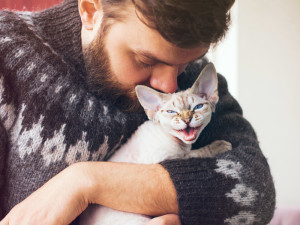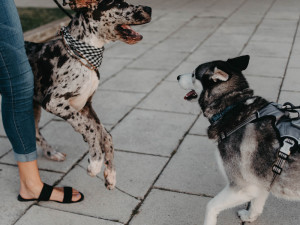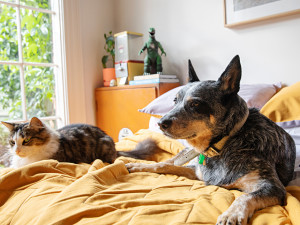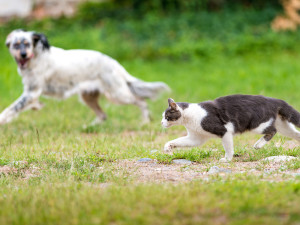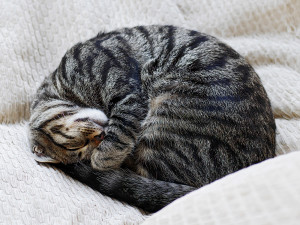The Real Differences Between Cats and Dogs
There’s no winning this argument, but here’s what you should know about parenting each perfect pet

Share Article
Welcome to the ultimate showdown: cats versus dogs. It’s a debate as old as time, and it’s not about to be settled anytime soon (because both are great). If you’re thinking about bringing a pet into your life, you’re in for a real treat. But whether you’re ‘team cat‘ or ‘team dog‘, there are some key things you should know before you make a decision about which pet is right for you.
Both cats and dogs make great pets, but they can have vastly different personalities, needs and care requirements. Cats are generally less active than dogs and require less exercise. They’re also generally more independent, though of course every cat is different and you could have a real cuddle bug on your hands. Dogs tend to require more exercise and attention (snuggles, anyone?), but can also be more destructive and aggressive than cats. So, which one is right for you? That depends on a few factors.

Get (totally free) deals for food, treats, accessories, tech and way more pet parenting must-haves.
Whether you resonate with the independent charm of cats or the effervescent warmth of dogs, both bring immense joy to our lives in their own delightful way. Let’s break down how dogs and cats compare.
Cats vs dogs
When we’re playing the dog and cat comparison game, things can get heated quickly. Hey, people love their pets, we get it. We’re not here for any hardcore hatred toward either cats or dogs, but when it comes down to it, there are some general things to consider about being a dog or cat parent.
Cat-parent considerations:
Independence: cats are independent creatures, capable of entertaining themselves and staying alone while you travel.
Small-space friendly: cats are well-suited for small living spaces like apartments, turning any nook into their playground.
Low maintenance: they’re not high-maintenance pets, giving you more ‘me time‘ than some others.
Companionship: cats are like cuddly confidants, always there to offer comfort and a listening ear.
No walking necessary: because cats go to the toilet in a litter tray, they don’t need to be let out to do their business.
Quieter: other than the occasional meow, cats keep pretty quiet.
Lifespan: in general, cats live longer than dogs.
Litter box duties: whilst cats don’t need to go to the bathroom outside, it does mean you’ll be cleaning that litter tray regularly – and honestly, it can be gross.
Scratching behaviour: vats may scratch furniture if not provided with appropriate alternatives.
Shedding: many cats shed, which can lead to fur around the home.
Independence: whilst independence can be a pro, it may also mean less interaction.
Hairballs: cats can develop hairballs, which can lead to occasional vomiting.
Dog-parent considerations:
Unconditional love: dogs are experts at dishing out love and loyalty.
Playful: they’re always up for a play session, making every day an adventure.
Social catalysts: dogs are natural icebreakers, helping you connect with fellow dog lovers.
Fitness motivators: their daily walks ensure you both stay active and healthy.
Endless entertainment: dogs have a knack for being hilarious and heartwarming at the same time.
Protectors and guardians: they’ll watch over your home and family with unwavering devotion.
Cuddle buddies: when it’s time to relax, they’re the best snuggle partners around.
Time commitment: dogs require more time commitment than cats, including daily walks and ample playtime.
Training effort: training and behaviour shaping take patience and consistency, and a lot of it.
More space needed: unless you have an apartment-friendly breed, dogs tend to need more space and benefit greatly from a backyard.
Noisy: dogs bark, and it can be loud. It’s something to keep in mind if you’ll be living in close quarters with other people.
Travel considerations: planning trips sans your pooch requires finding a dog sitter or kennels, which you’ll need to budget for.
More expensive: caring for a dog generally costs more than caring for a cat.
Ultimately, something that’s a pro for one pet parent might be con for another. Take the independent nature of cats, for example. One person might see this as a major benefit because they want a pet who has an easy time self-entertaining, while another person might see this as a disadvantage because they want a companion who gives them all the attention. Personal preference and lifestyle play a huge role when deciding between a cat and a dog.
Cat vs dog: care
When we look at the different needs of cats and dogs, care is an important aspect to consider. From a health perspective, both cats and dogs need regular veterinary care, and those vet visits can add up quickly, so make sure that piggy bank is stocked before you welcome any four-legged friend into your home. They also both require daily feedings with a balanced diet and fresh water. But outside of vet visits and feeding requirements, dogs tend to need more care than cats.
You’ll want to ensure your pup has daily exercise, which means a few walks, a couple play sessions and maybe a good run at the park. Training and socialisation are also part of the package, ensuring your dog is well-behaved and gets along well with other people and pets. Grooming needs vary by dog breed, but expect some brushing and occasional baths. And last but not least, dogs need loads of love and attention – they thrive on it.
The care requirements for cats are by no means easy, but they are lower maintenance pets by nature. First and foremost, ensuring they have a litter tray that’s cleaned regularly is essential – no one wants a dirty toilet or a stinky house. It’s also important to fulfil your feline’s need to scratch…a lot. Having scratching posts or pads around your house can save your furniture from their fury. While cats are relatively low-maintenance, they do enjoy playtime, so interactive toys are a hit. And lastly, don’t forget to have plenty of cosy spots for them to curl up and nap – they’re experts in the art of relaxation.
It’s important to look at the different lifestyles that are compatible with cats and dogs. If you have the time to dedicate to daily walks, training sessions and games of fetch, being a dog parent might just be the move for you. If you’re more into the sit-back-relax-and-occasionally-cuddle lifestyle, a cat is probably more your speed.
Cat vs dog: behaviour
Comparing cat and dog behaviour is a bit like comparing apples to oranges. While both cats and dogs have their own quirks, individual personalities and breeds play a significant role. Generally, dogs are the daylight adventurers, ready for a game of fetch or a brisk walk around the block. Cats are the daytime dreamers, masters of catnaps and contemplation. But when nighttime comes around, cats often come to life, chasing imaginary prey or zooming through the house like tiny tornadoes. Generally speaking, dogs are dependable extroverts and thrive on social interaction, while cats are enigmatic introverts who strongly value their ‘me time‘.
As far as mischief goes, cats can be the masterminds behind some playful chaos, like knocking over your favourite vase just because it looked at them funny. Dogs, however, might dive headfirst into more serious trouble territory, from barking marathons and aggression to chewing exploits and accidental pee puddles. The good thing is that proper training can work wonders for both dog and cat behavioural issues.
Cat vs dog: personality
When looking at cat and dog personality traits, each brings their own set of unique characteristics to the table. Cats tend to be independent spirits, masters of lounging and self-entertainment. They’ll curl up in your lap when they’re in the mood, but are equally content going solo. They’re also stealthy and mysterious, often serving that aloof side-eye, but it’s all part of their ever so slightly cryptic charm.
Dogs, on the other hand, are all about the social scene. They’re your adventure buddies, always ready for a game of tug-of-war or walk in the park. They wear their hearts on their furry sleeves and are the eternal optimists, showering you with tail wags and slobbery kisses.
Cat vs dog: intelligence
People have strong opinions when it comes to the intelligence of cats versus dogs. Some assume that cats are smarter because of their fearless independence and impressive problem-solving skills. Others believe that a dog’s trainable nature and ability to work jobs like search and rescue mean that canines have all the brains. But the truth is that it’s a little more complicated than that.
It comes down to how intelligence is defined. Because we can’t really compare cat and dog IQs, we look at three different types of intelligence: cognitive, emotional and practical. Cognitive intelligence is about problem-solving and learning from experience; emotional intelligence is related to understanding and responding to emotions, and practical intelligence involves applying skills effectively to survive. In general, cats tend to have higher practical intelligence with their sharp hunting skills, while dogs are more emotionally intelligent given their ability to understand humans.
Cat vs dog: body language
An animal’s body language can tell you a lot about how they’re feeling and what they’re about to do. Ever see a dog’s ears flip back and tail wag before they make a playful leap? That’s body language. For both cats and dogs, their body parts literally speak for them. They use their eyes, ears, tails, mouths and posture to communicate.
Although they may use the same body parts to send a message, the meaning behind those movements isn’t always the same. Take ears for example. When a cat’s ears go back, that typically means they’re afraid, angry or feeling uncomfortable. When a dog’s ears go back slightly, that likely means they’re feeling friendly, especially when this is accompanied by a wagging tail. If a dog’s ears are pinned back sharply and they’re gritting their teeth and tucking their tail, this can indicate that they’re feeling defensiveopens in new tab.
Here are some other differences between cat and dog body language to help you decode their feelings:
Tail talk: cats use their tails to share their feelings. When you see a cat’s tail twitching or fluffed up, it might mean they’re a bit agitated. Meanwhile, dogs are tail-wagging champions, expressing their excitement and joy through this spirited movement.
Facial expressions: dogs are known for their expressive faces, from those irresistible ‘puppy eyes‘ to heart-melting grins. Cats are a bit more subtle, but they show trust by giving you slow blinks.
Purring versus growling: cats might purr to show contentment or when they want some love, but growling signals they’re not thrilled. Dogs, on the other hand, growl as a warning or when they’re annoyed.
Approach style: cats like to keep their cool, often approaching with a slow slink or graceful prowl. Dogs, on the other hand, can’t contain their enthusiasm and might bound over to you or even jump up to say hello.
Cat vs dog: cost
The cost of having a pet can vary widely depending on factors like size, breed, and overall health. But generally, dogs tend to be a bit more expensive to care for than cats. Dogs typically need more food, grooming and medical attention, which can add up over time. Dog parents will also spend more on training, boarding and pet-sitting services. Cats, on the other hand, don’t require as much food and are more independent, needing less attention and time. What we do know is that the love and companionship you receive from both cats and dogs is priceless.
Key differences between cats and dogs
From care needs and cost to body language and behaviour, there are plenty of differences between cats and dogs. While these characteristics can vary by the individual pet, here are the key takeaways:
Cats are independent, while dogs are more dependent.
Cats are lower-maintenance overall, while dogs require a different kind of care and attention.
Cats prefer solitary pursuits, while dogs provide more companionship and emotional bonding.
Cats tend to cost less than dogs.
Cats typically live longer than dogs.
If you’re still trying to decide between a cat and a dog, ask yourself: does having a pint-sized enigma wrapped in fur as your companion sound like fun to you? Then cat parent it is. If a life filled with wagging tails, wet noses and adventures with a boundless-joy-filled beast sounds more appealing, ‘team dog‘ might be more your style. Whether you’re a cat person, dog person, or both, one thing’s for sure – there will be no shortage of love and laughter in your life when you share it with these four-legged fur balls.
At the end of the day, as much as we might want to put our companions into boxes based on characteristics like behaviour, care and personality, it’s not black and white – each one comes with their own unique set of qualities, and that’s what makes them so special.
Frequently asked questions
Which pet is better for smaller living spaces, like apartments?
While certain dog breeds make great apartment pets (think Shih Tzus, Yorkshire Terriers, and Chihuahuas), cats are generally better pets for apartment living because they require less space and don’t make as much noise. With that said, dogs are extremely trainable, and if you put in the effort to train them and provide lots of enrichment and exercise every day, they might be just fine.
Do cats and dogs have different communication styles?
While both cats and dogs use body language to communicate, they’re pretty different in how they express themselves. Cats often use subtle body language to convey their feelings. A cat with a twitching tail might be a bit agitated, while slow blinks are a sign of trust and affection. Felines also purr when they’re feeling content or seeking attention. Dogs, on the other hand, are more overt in their communication.
Tail wagging usually signifies excitement and happiness, but it can also mean stress or anxiety. They bark to express various emotions (much to our dismay sometimes), whether they’re defending your home against the mailman or wanting some playtime. Regardless of whether you have a cat or a dog, understanding your pet’s body language is key to building a strong bond.
Are there differences in the lifespans of cats and dogs?
On average, cats tend to live longer than dogs. Many cats live into their late teens, and some even reach their 20s. While factors like breed, genetics and overall health play a role, indoor cats typically have a longer life expectancy because they have less exposure to risks, such as accidents and diseases.
The lifespan of dogs varies significantly by breed and size. On average, dogs typically live around 10-13 years, though some smaller breeds can live as long as 15 years. Providing them with a balanced diet, regular exercise and routine vet care can help extend your dog’s life.

Courtney Elliott
Courtney Elliott, a proud Cleveland native living in Manhattan, blends her decade of writing and editing expertise with her unshakable devotion as a pet parent to her French Bulldog, Gus. When she’s not at her desk, you’ll find her frolicking in Central Park or engrossed in a good book at a local coffee shop.
Related articles
![Two Golden Retriever puppies playing with a large blue tennis ball outside in the grass]()
What to Expect At Puppy Socialisation Classes
A dog behaviourist schools us on why puppy classes are more about socialising than getting straight As
![mom and daughter playing with puppy]()
How to Introduce Your New Dog to Your Kids
They’ll always remember their first childhood pet – this intro is just the beginning
![cat staring at person on table]()
Why is My Cat Giving Me the Evil Eye?
...Is it something I said?
![Curled up tabby cat sleeping on pillows]()
How Many Cat Naps Is Too Many?
A very sleepy kitty isn’t usually a problem, but watch out for these signs of medical distress



